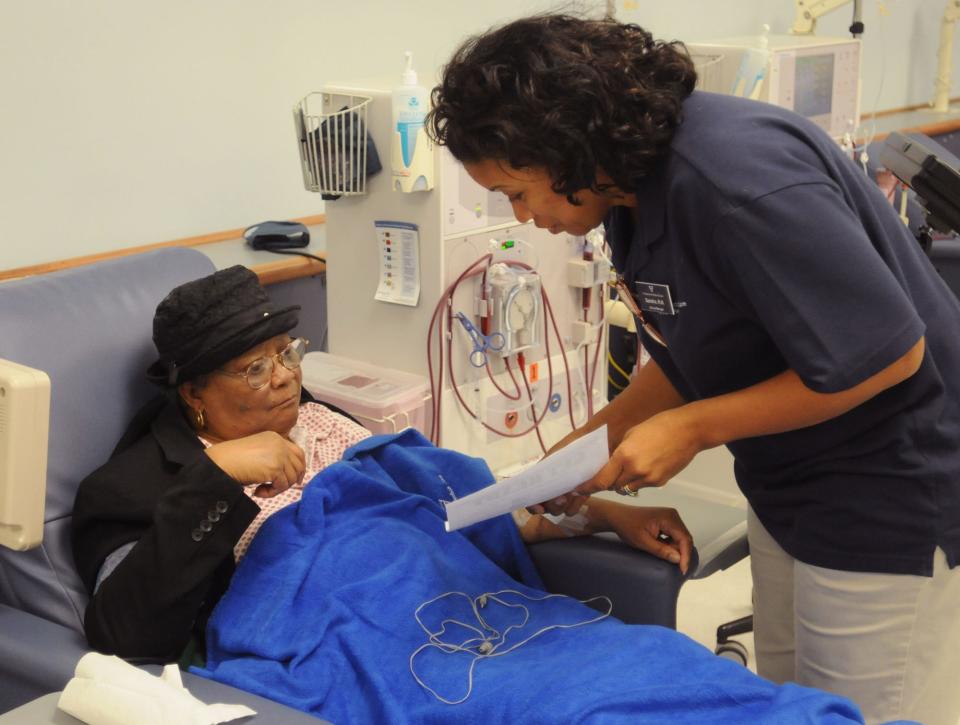Can kidney dialysis be done at home? We can make treatment more accessible, so why aren't we?
In 2014, Amber Pettis felt nauseous and tired. She went to see her doctor because she thought she had a stomach bug. Instead, she learned she had kidney failure, a life-altering disease requiring long-term dialysis or a kidney transplant to survive.
In that short visit, Amber’s life changed.
She “crashed” into dialysis and had to put her life on hold. Instead of her plan to see the world, she "traveled" to a dialysis unit three times a week, where she was hooked up to a machine to clean her blood. On the days when she was off dialysis, she felt wiped out and spent the time just trying to recover.
Amber’s story is common.
Few patients know about home dialysis
More than 800,000 Americans live with kidney failure and half will die within five years.
While kidney transplantation can help patients live longer, few organs are available and about 100,000 people are stuck on a transplant waitlist.
Kidney transplant could save my life: But only half of all eligible Americans are registered organ donors
Unfortunately, deep inequities also exist. Black Americans are more likely to develop kidney failure than white Americans, and are half as likely to receive a kidney transplant.
Home dialysis could have given Amber the flexibility to personalize her treatment and even travel the world. But no one discussed home dialysis with her until months later. Once she discovered the option, she switched to it and felt much better.
Nearly a decade later, few patients in the United States get the chance to choose home dialysis. This is disappointing, as home dialysis benefits patients while also being cheaper for the taxpayers who fund Medicare. These advantages are so apparent that 90% of kidney clinicians would choose home dialysis if they needed it.
In contrast, only 13% of patients in America receive home dialysis.

To fix this, the federal government issued an executive order in 2019, the Advancing American Kidney Health initiative, which calls for 80% of new patients with kidney failure to receive home dialysis or get a transplant. But, as Amber’s story suggests, that shift faces many obstacles.
In-center dialysis has been the default therapy for kidney failure for more than 50 years. Even now, it takes kidney clinicians far more time and effort to arrange for home dialysis. Instead, many patients “crash” into the hospital with kidney failure and begin in-center dialysis.
Patient-centered care improves, but challenges remain
Some progress has been made. Medicare payment models have attracted new companies –like Somatus, Monogram Health and Strive Health – to innovate.
Penn Medicine is working with another startup, Evergreen Nephrology, to provide more patient-centered care, including home dialysis.

But many challenges remain. Kidney care is incredibly fragmented. Often, the nephrologist caring for patients before dialysis is different from the one who provides their dialysis or evaluates them for a transplant. These nephrologists often face communication barriers because they work in different systems.
Another problem is that many kidney doctors graduate from training without feeling prepared to treat patients on home dialysis. The American Society of Nephrology and other organizations are working to enhance education for trainees.
Home Dialysis University, led by Dr. Joel Glickman at the University of Pennsylvania, is one such training resource.
Lastly, we face a critical workforce shortage. Few nurses are skilled to provide home dialysis training, and we lose many of them due to low salaries and inflation.
The bar of entry to become home dialysis nurses is also arbitrarily high. Legislators should consider ways to ease the requirements for credentialing, improve reimbursement to raise nursing salaries, and allow for more staff to support home dialysis nurses.
Overwhelming worker-to-patient ratios: Understaffing at hospitals puts our patients at higher risk
Better system would make home dialysis more accessible
If we had solved these problems years ago, Amber might have started her journey with home dialysis, avoiding several painful and costly hospitalizations.
Fortunately, she received a kidney transplant in 2015 and is now off dialysis. The Memphis resident is now a patient advocate for the National Kidney Foundation and, driven by the challenges she witnessed on dialysis, is an apostle for home dialysis.
Opinion alerts: Get columns from your favorite columnists + expert analysis on top issues, delivered straight to your device through the USA TODAY app. Don't have the app? Download it for free from your app store.
As a patient advocate, Amber now meets with patients to talk about how home dialysis can allow people to "have life" in the midst of end-stage renal disease, just as it did for her.
Not everyone can do home dialysis. Some patients lack dexterity or a clean environment to perform dialysis.

Yet, these barriers could be overcome by a new system that better supports patients and clinicians.
The 2019 executive order created our biggest opportunity to build a better system. The question is: What will it take to achieve it?
Dr. Yuvaram Reddy is a nephrologist at the University of Pennsylvania with a focus on health equity. He is also a senior fellow at the Leonard Davis Institute of Health Economics. Amber Pettis is a person living with kidney failure and a patient advocate with the National Kidney Foundation. Amber crashed into in-center hemodialysis, switched to home dialysis and is now living with a kidney transplant. Amber and Yuvaram work together on research projects to identify new ways to improve access to home dialysis for people living with kidney failure.
You can read diverse opinions from our Board of Contributors and other writers on the Opinion front page, on Twitter @usatodayopinion and in our daily Opinion newsletter.
This article originally appeared on USA TODAY: Can kidney disease be treated? How home dialysis can help

